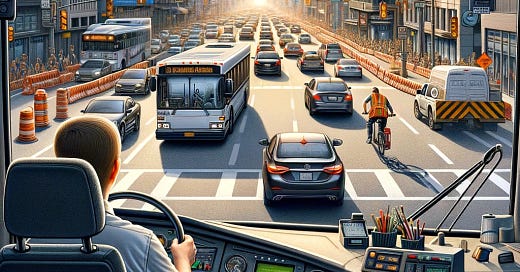Steering Thru Stress: What Bus Drivers' Working Lives Teach Us About Wellbeing
Transit operator job stress offers lessons for employee wellness in all occupations
The job stress of city transit operators, especially bus drivers, has probably been studied more than any other occupation. Along with other jobs in the transportation industry, bus driving is often cited as one of the most stressful jobs.
Though it may seem esoteric to office workers, the lessons we’ve learned about bus driver stress are relevant to almost everyone.
Exact Change… of the Work (Not the Worker)
A key takeaway is summarized in the International Labor Organization’s publication Bus Drivers: Occupational Stress and Stress Prevention:
Societies ought to optimize the work environment so that most workers can enjoy productive and satisfactory experiences on their jobs rather than attempting to find the few hardy souls who can withstand the demands and pressures of poor work settings.
Worker advocates have endorsed organizational and environmental changes over personal interventions (like mindfulness, resilience training, and stress management) for decades, most recently in a study featured in the New York Times and other outlets. The study concluded:
More emphasis must be placed on the greater benefits of organisational rather than individual change.
Fifty years of research validates that driving a bus is super-stressful, and it suggests that managing the job’s physical and mental health risks should focus on changing the work, not the worker.
In other words, employers should manage exposure to stressors — not just teach coping strategies — in the same way they’re expected to minimize physical hazards rather than hand out painkillers to injured workers. (Organizational interventions that reduce exposures, however, are no panacea. Person-level interventions have their place.)
Most of the research on bus driver stress takes place through the lens of job strain models, which, simply put, attribute harmful stress to high demands in the context of low levels of control (autonomy) and weak social support.

(A related model links harmful stress to an imbalance of effort and rewards1. Another holds that job characteristics can be categorized as demands or resources, levers that influence wellbeing, burnout, and work engagement2. )
Slate.com in 2011 summarized bus driver research in The Most Stressful Job on the Planet? For bus drivers, streets are crowded. Passengers are cranky. And there’s always the chance you might get punched.
Slate’s headline captures only a sliver of the risks to bus drivers’ wellbeing. An earlier review3 of 27 studies found the job’s unique stressor profile includes:
Inflexible schedules
Rotating and split shifts
Inadequate breaks
Heavy traffic
Passenger violence
Poor driver-seat ergonomics.
The risks lead to harmful outcomes for bus drivers…
Physical — cardiovascular disease, gastrointestinal disorders, musculoskeletal problems, fatigue;
Psychological — depression, anxiety, post-traumatic stress disorder;
Behavioral — substance use disorders;
… and unwelcome consequences, for municipalities and passengers, caused by high rates of:
Absenteeism
Turnover
Accidents.
These findings have been reproduced and expanded in transit operations worldwide.
Transit Operators Are Still Thrown Under the Bus
Serious research on job strain has waned in the last 15 years, in my estimation, yielding to more consumer-oriented studies of resilience training, mindfulness, and mental health apps.
But there’s no reason to believe bus drivers’ plight has improved.
A 2016 French study of transit operators, for example, found:
Drivers’ health and well-being at work has deteriorated... Besides the usual risks, new forms of work intensification have emerged, linked to budgetary constraints, urban policies, quality control, geolocation, and verbal and physical assaults.
Around that same time, a small US study of transit workers reported in its paper, Trouble in Transit — Organizational Barriers to Workers’ Health, that “entrenched organizational practices, particularly management’s leadership style… created an atmosphere of distrust. High demanding work schedules, as a result of technological advances, were [related] to diminished breaks, fatigue, and unhealthy diets.”
The Healthy Work Campaign’s Marnie Dobson (a Heigh Ho subscriber), along with Bong Kyoo Choi and Peter Schnall, published a qualitative study of bus drivers in Southern California, Work Organization, Health, and Obesity in Urban Transit Operators.
Dobson’s study features transit operators’ reports of how intense stress and work organization affect their health and wellbeing. For example, it spotlights threat avoidant vigilance — the demands of maintaining a high level of alertness to avoid catastrophe — which has been linked to transit operator hypertension and cardiovascular disease.
One driver quoted in the study explained:
... [Other motorists] cut us off. They don’t respect the bus… We have to make a decision. We have three seconds at most to either hit the car, slam on our brakes, or throw somebody over… [An accident review board is] going to charge us and say, “You should have done this and you should have done that.” …But the reality is, we have a second to react… There’s a lot of stress factors for us operators.
Dobson’s study also includes testimonials about feeling unvalued by managers; schedule pressures; fatigue; hostile passengers; obstacles to employee wellness program participation; and other stressors that pervade transit operators’ working life.
All hell broke loose during COVID. In the summer of 2020, a study found, transit operators reported significantly heightened work stress, intentions to quit, and job insecurity.4
Reroute Job and Work Design
The Healthy Work Campaign offers resources, case studies, and research articles with examples of how jobs and work, including the work of transit operators, can be redesigned to help protect employee wellbeing.
“Most wellness programs place responsibility for health on bus drivers and not on the work environment,” the Healthy Work Campaign notes. In contrast, it describes more comprehensive interventions in Stockholm and in Copenhagen:
In Stockholm, this included physical route changes, such as separate bus lanes, passenger peninsulas, and electronic bus schedule information in buses and at bus stops, which were innovations in the 1990s…
The Copenhagen project went much further and included many programs and policies involving improvements in scheduling, holiday time, taking time off, and communication; development of skills, such as training in management and communication, improved training of new hires, and providing courses on topics like handling conflicts, threats and violence; and improvements to and replacement of buses and radio systems.
The Copenhagen HealthyBus Project, in fact, encompassed 200 interventions — identified largely through an employee participative process — designed to improve the health and wellbeing of 3500 bus drivers, with good results5:
Three years after the interventions were launched, follow-ups revealed remarkable improvements such as reductions in stress and body pains, an increase in satisfaction, and improvements in management.
Muni Drivers Leave Their Hearts in San Francisco
In the US, one of the most studied transit operator groups is the San Francisco Municipal Railway (Muni), the subject of a 26-year health and safety project6. Early on, the study showed Muni drivers to be at risk for high blood pressure7 and the investigators cited “60 studies worldwide confirming the high prevalence of hypertension and cardiovascular disease among bus drivers.”8
The Healthy Work Campaign describes the results of Muni interventions, with a cautionary tale about what can happen when an employer disregards Peter’s stress to relieve Paul’s:
The aims of the program were to increase the numbers of buses and drivers on certain routes, have less rushed running time, improved recovery time for bus drivers,… and the chance for riders to receive education about the system. Because the project involved an inadequate budget and a limited number of vehicles, buses were taken away from another route, resulting in increased stress due to fewer buses on the other route. The pilot project was not continued or expanded.
Next Stop: Real Life
The next issue of Heigh Ho features an interview with a current Muni driver — Mc Allen, who authored the anecdote in Heigh Ho’s last issue, A Bus Driver's Story of Connection, Kindness, and Trust.
In the interview, Mc elaborates on his love of his job while sharing a clear-eyed view of its challenges. Available in audio with a text excerpt, it’s a compelling firsthand account that evokes ideas for elusive organizational solutions. It breathes life into everything discussed in this post, with takeaways on how to alleviate the stressors in almost any job.





Great article, Bob! You may also be interested in a 2023 report on this issue from the International Transport Workers Federation, "Essential public services, essential workers’ health: union-based initiatives to protect the mental health of young public transport workers" (210 pages, 33 MgB): https://www.itfglobal.org/en/news/essential-public-services-essential-workers-health-union-based-initiatives-protect-mental
A briefing paper to accompany this report is also available here (10 pages, 1.4 MgB, attached):
https://www.itfglobal.org/en/reports-publications/essential-public-services-essential-workers-health-briefing-paper
Another well researched and well thought through article, thanks Bob. While I love the specifics and the detail, the opening quote from the study in the NYT feels like a rallying call or mantra for our industry: "More emphasis must be placed on the greater benefits of organisational rather than individual change." I'll be using that myself, if you don't mind :-)